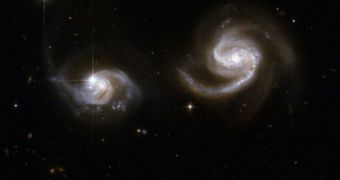Some 93 years ago, a famous physicist introduced a term in his equations that was meant to explain how the Universe was stationary in his theory. Though he later regretted this, astrophysicists are now saying they can use it to explain how the Universe functions.
While developing his famous theory on general relativity, the expert decided to introduce a cosmological constant in his equations, that would play the role of making the calculations in tune with the current view at the time, that the Universe was stationary.
Years passed, and the scientific community revealed that the Cosmos was in fact expanding. This led Einstein to call the constant the biggest failure of his scientific life.
But modern physicists do not agree with the great scientist on that. They say that the concept can be used to explain the existence and behavior of dark energy, a force that is believed to be permeating the Universe.
Its role is to underlie the constantly-accelerating cosmic expansion, and to provide a strong opponent for gravity. Without this energy, the thinking goes, the Universe would have no choice but to collapse in on itself.
In a new scientific investigation, experts managed to establish that the cosmological constant provides the best known fit for dark energy developed to date. The team even managed to provide the most accurate estimate of its value, Space reports.
The way these results were achieved was by studying the geometry of the Universe, which the team found to be flat, rather than spherical or curved, as past investigations had suggested.
In the past, researches on dark energy were very tightly linked, in the sense that methods of studying the stuff were derived from other studies, and vice-versa.
What is new about the recent approach is that it does not have any connections with past theories or concept, say authors Christian Marinoni and Adeline Buzzi, who are both physicists at the Universite de Provence in France.
They say that observing pairs of very distant galaxies can provide a clear indication as to the overall curvature of the Universe. “The most exciting aspect of the work is that there is no external data that we plug in,” Marinoni explains.
“We have at this moment the most precise measurements of lambda that a single technique can give,” the expert goes on to say. The work is detailed in the November 25 issue of the journal Nature.
“Our data points towards a cosmological constant because the value of lambda we measure is close to minus one, which is the value predicted if dark energy is the cosmological constant,” he goes on to say.
But the team admits that not even these advancements in science can answer the most fundamental question about dark energy, and namely why does it exist at all? Theoretically, this shouldn't have happened.
“Many cosmologists regard determining the nature of dark energy and dark matter as the most important scientific question of the decade,” explains University of Edinburgh expert Alan Heavens.
“Our picture of the Universe involves putting together a number of pieces of evidence, so it is appealing to hear of Marinoni and Buzzi's novel technique for testing the cosmological model, not least because it provides a very direct and simple measurement of the geometry of the Universe,” he adds.

 14 DAY TRIAL //
14 DAY TRIAL //